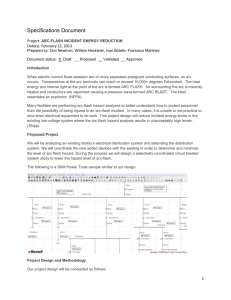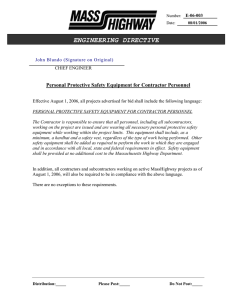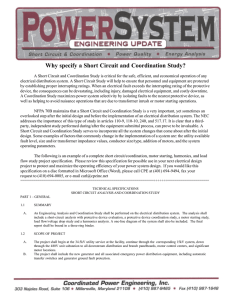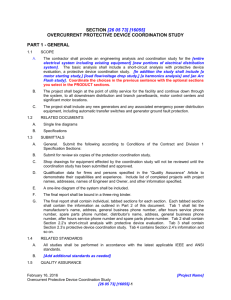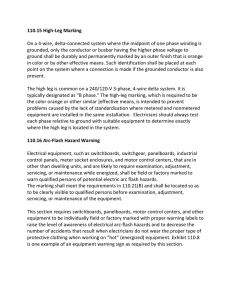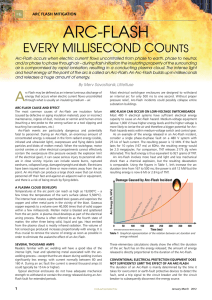SECTION 16015 SHORT-CIRCUIT/COORDINATION STUDY/ARC
advertisement
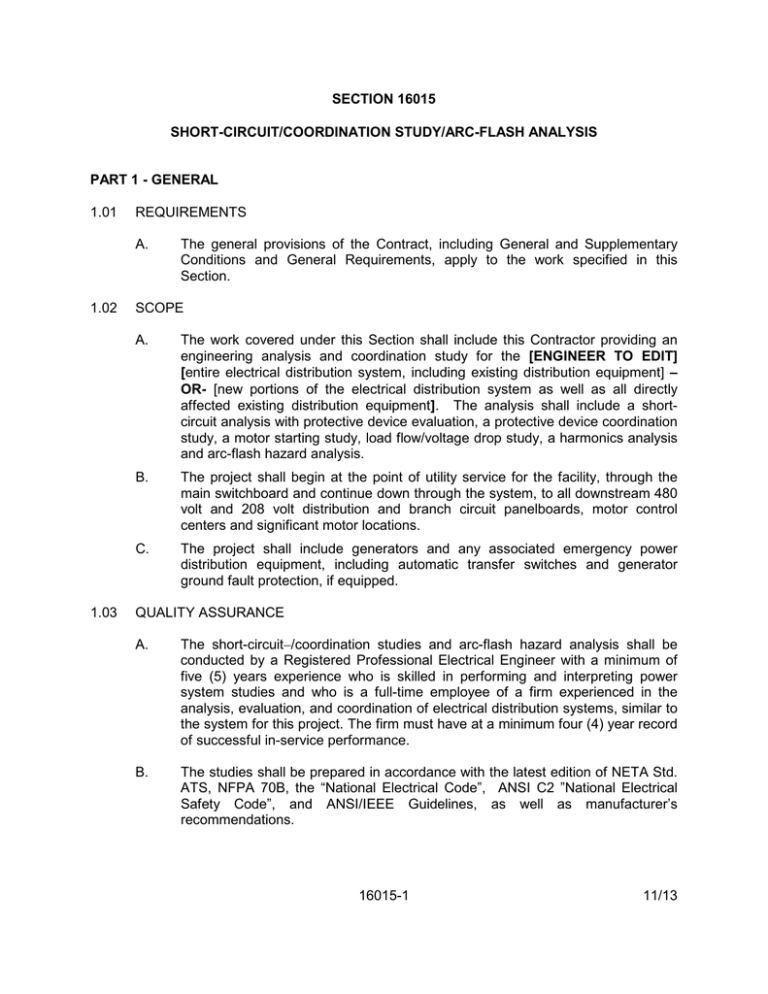
SECTION 16015 SHORT-CIRCUIT/COORDINATION STUDY/ARC-FLASH ANALYSIS PART 1 - GENERAL 1.01 REQUIREMENTS A. 1.02 1.03 The general provisions of the Contract, including General and Supplementary Conditions and General Requirements, apply to the work specified in this Section. SCOPE A. The work covered under this Section shall include this Contractor providing an engineering analysis and coordination study for the [ENGINEER TO EDIT] [entire electrical distribution system, including existing distribution equipment] – OR- [new portions of the electrical distribution system as well as all directly affected existing distribution equipment]. The analysis shall include a shortcircuit analysis with protective device evaluation, a protective device coordination study, a motor starting study, load flow/voltage drop study, a harmonics analysis and arc-flash hazard analysis. B. The project shall begin at the point of utility service for the facility, through the main switchboard and continue down through the system, to all downstream 480 volt and 208 volt distribution and branch circuit panelboards, motor control centers and significant motor locations. C. The project shall include generators and any associated emergency power distribution equipment, including automatic transfer switches and generator ground fault protection, if equipped. QUALITY ASSURANCE A. The short-circuit /coordination studies and arc-flash hazard analysis shall be conducted by a Registered Professional Electrical Engineer with a minimum of five (5) years experience who is skilled in performing and interpreting power system studies and who is a full-time employee of a firm experienced in the analysis, evaluation, and coordination of electrical distribution systems, similar to the system for this project. The firm must have at a minimum four (4) year record of successful in-service performance. B. The studies shall be prepared in accordance with the latest edition of NETA Std. ATS, NFPA 70B, the “National Electrical Code”, ANSI C2 ”National Electrical Safety Code”, and ANSI/IEEE Guidelines, as well as manufacturer’s recommendations. 16015-1 11/13 SHORT-CIRCUIT/COORDINATION STUDY/ARC-FLASH ANALYSIS C. 1.04 SECTION 16015 The firm conducting the study shall have one million dollars worth of Professional Liability Insurance in addition to standard general insurance. SUBMITTALS A. Submittals are required in accordance with SECTION 16010 of these specifications. B. The short-circuit and protective device coordination studies shall be submitted to this project’s Design Engineer of record prior to receiving final approval of the distribution equipment shop drawings and/or prior to release of equipment drawings for manufacturing. If formal completion of the studies may cause delay in equipment manufacturing, approval from the Design Engineer of record may be obtained for preliminary submittal of sufficient study data to ensure that the selection of device and characteristics will be satisfactory. Generally, shop drawing submittals for equipment effected by the coordination study will not be reviewed until the short-circuit/coordination study has been submitted and successfully reviewed. C. The results of the short-circuit, protective device coordination, and arc-flash hazard analysis studies shall be summarized in a final report. Submit bound copies of the final report with tabbed sections, in the quantities required. Additional copies, where required, shall be provided on CD in PDF format. D. The report shall include, but not be limited to, the following sections: 1. One-line diagram showing protective device ampere ratings and associated designations, cable size & lengths, transformer kVA and voltage ratings, motor and generator kVA ratings, switchboard and panelboard designations. 2. Descriptions, purpose, basis and scope of the study. 3. Tabulations of the worst-case calculated short circuit duties as a percentage of the applied device rating (automatic transfer switches, circuit breakers, fuses, etc.); the short circuit duties shall be upwardadjusted for X/R ratios that are above the device design ratings. 4. Protective device time versus current coordination curves with associated one line diagram identifying the plotted devices, tabulations of ANSI protective relay functions and adjustable circuit breaker trip unit settings. 16015-2 11/13 SHORT-CIRCUIT/COORDINATION STUDY/ARC-FLASH ANALYSIS SECTION 16015 5. Fault study input data, case descriptions, and current calculations including a definition of terms and guide for interpretation of the computer printout. 6. Details of the incident energy and flash protection boundary calculations. 7. Sample of an arc-flash hazard warning label. 8. Comments and recommendations for system improvements, where needed, including extending of feeder or other conductors necessary to lower the fault-current to an acceptable level. 9. Executive summary. PART 2 - PRODUCTS 2.01 2.02 STUDIES A. Contractor shall furnish short-circuit and protective device coordination studies as prepared by the electrical distribution equipment manufacturer or an approved engineering firm. B. Contractor shall furnish an Arc-Flash Hazard Analysis Study performed in compliance with the latest edition of IEEE Standard 1584 – “IEEE Guide for Performing Arc-Flash Hazard Calculations” and per NFPA 70E – “Standard for Electrical Safety in the Workplace”, reference Article 130.3 and Annex D, prepared by the electrical distribution equipment manufacturer or an approved engineering firm. DATA COLLECTION A. Contractor shall furnish all field data as required by the power system studies and arc-flash hazard analysis. The Study Preparer shall furnish the Contractor with a listing of required data. The Contractor shall expedite collection of the data to eliminate unnecessary delays and assure completion of the studies as required for final approval of the distribution equipment shop drawings and/or prior to the release of the equipment for manufacturing. B. Source contribution may include present and future utility supply, motors, and generators. C. Load data utilized may include existing and proposed loads obtained from Contract Documents provided by Owner or Contractor. 16015-3 11/13 SHORT-CIRCUIT/COORDINATION STUDY/ARC-FLASH ANALYSIS D. 2.03 Include fault contribution of existing motors in the study, with motors < 50 hp grouped together. The Contractor shall obtain required existing equipment data, if necessary, to satisfy the study requirements. SHORT-CIRCUIT ANALYSIS WITH PROTECTIVE DEVICE EVALUATION A. Systematically calculate fault currents based on the available fault current at the facility service entrance. Study preparer shall obtain the available fault current from the local utility. B. Short-circuit calculations shall be prepared by means of a digital computer utilizing a commercially available software package. Motor contribution shall be incorporated in determining fault levels. Results of short-circuit calculations shall be presented in tabular form and shall include momentary and interrupting fault values for three-phase and phase-to-ground faults. C. Analyze the short-circuit currents by preparing a tabulation comparing the fault levels to the device interrupting ratings. Indicate areas in which integrated/series ratings are utilized. The following information shall be included in the tabulation: 1. 2. 3. 4. 5. 6. 2.04 SECTION 16015 Bus identification number. Location identification. Voltage Manufacturer and type of equipment. Device rating. Calculated short-circuit current. PROTECTIVE DEVICE COORDINATION STUDY A. Prepare coordination time-current characteristic curves to determine the required settings/sizes of the protective devices to maximize selectivity. The utility upstream protective device feeding the facility shall be maintained as the upper limit for coordination. These settings shall be obtained by the preparer, along with any other protective device setting requirements. The coordination curves shall be prepared on log-log paper and illustrate adequate clearing times between series devices. The curves shall be created through the use of the study software package, but must reflect actual protective devices to be installed. Adequate time-current curves shall be generated to depict coordination. In addition, protective device characteristics shall be suitably determined to reflect calculated short-circuit levels at the location. B. A narrative analysis shall accompany each coordination curve sheet and describe the coordination and protection in explicit detail. All curve sheets shall be multi-color for improved clarity. Areas lacking complete coordination shall be highlighted and reasons provided for allowing condition to remain or provide solution to resolve situation. The following information shall be provided on all curve sheets: 16015-4 11/13 SHORT-CIRCUIT/COORDINATION STUDY/ARC-FLASH ANALYSIS 1. 2. 3. 4. 5. 6. 7. 8. 2.05 A motor starting study will be prepared in order to analyze the transient effect of the system’s voltage profile during motor starting. Significant motor starting voltage profiles must be calculated in order to analyze the effects of the motor starting on a system basis. The voltage profile as a result of motor starting will be analyzed based on ANSI/IEEE requirements. The system loading for the motor starting study will be in accordance with the Load-Flow/Voltage Drop Study as detailed above. The motor starting study calculations must be performed using a digital computer utilizing commercially available software. HARMONICS ANALYSIS A. 2.08 A load-flow and voltage drop study will be performed to determine the steadystate loading profile of the system. This analysis will be conducted under two modes of operation. The loading under the first mode of operation will be based on the instantaneous load values collected during the field effort. The loading under the second mode of operation will be based on an 80% design criteria of the load centers. From the results of the load-flow/voltage drop calculations, an analysis will be prepared, based on the NEC, to indicate areas of overloaded conductors/loadcenters and areas of excessive voltage drop in the conductors. The load-flow/voltage drop study calculations must be performed using a digital computer utilizing commercially available software. MOTOR STARTING STUDY A. 2.07 Device identification and associated settings/size. Voltage at which curves are plotted. Current multiplier. ANSI frequent fault damage curve. Cable insulation damage curves. Transformer inrush point. Single-line for the portion of the system. Motor starting profiles (where applicable). LOAD-FLOW/VOLTAGE DROP STUDY A. 2.06 SECTION 16015 The harmonic analysis shall be performed by a computer aided circuit simulation of the distribution system specific to this project. These calculations shall show that the total harmonic voltage distortion shall be less than five (5) percent due to the contribution of all VFD’s supplied. ARC-FLASH HAZARD ANALYSIS A. The Arc-Flash Hazard Analysis shall be performed by a computer aided circuit simulation of the distribution system specific to this project. These calculations shall determine the Arc-Flash Incident Energy (AFIE) levels and flash protection boundary distances. The flash protection boundary and the incident energy shall be calculated at all significant locations in the electrical distribution system 16015-5 11/13 SHORT-CIRCUIT/COORDINATION STUDY/ARC-FLASH ANALYSIS SECTION 16015 (switchboards, panelboards, busway, generators, automatic transfer switches, and motor-control centers) where work could be performed on energized parts. 2.09 B. The Arc-Flash Hazard Analysis shall be performed in conjunction with the ShortCircuit/Coordination Study. C. Results of the analysis shall be submitted in tabular form and shall include as a minimum the bus name, bolted fault current and arcing fault current level, flash protection boundary distances, personal protective equipment (PPE) hazard risk category and the AFIE levels. D. The analysis shall be performed under worst-case Arc-Flash conditions, and the final report shall describe the worst-case conditions when different from worstcase bolted fault conditions. E. Arc-Flash Warning Labels: 1. The Contractor of the Arc-Flash Hazard analysis shall provide Arc-Flash Warning labels for all electrical equipment that may be opened or accessed while energized. Labels shall be minimum 3.5 inch x 5 inch thermal transfer type of high adhesion polyester. Labels shall be machine printed, with no field markings. 2. All labels shall be based on recommended overcurrent device settings and shall be provided after the results of the analysis have been presented to the Owner and after any system changes, upgrades or modifications have been incorporated in the system. The labels shall identify the flash protection boundary, the arc-flash incident energy (AFIE) level, working distances, required personal protective equipment (PPE) hazard risk category, nominal voltage, and engineering report number, revision number and issue date. SINGLE-LINE DIAGRAM A. The final report shall include a multi-color single-line diagram of the electrical distribution system within the scope of the project. The single-line shall include: 1. 2. 3. 4. 5. Transformer rating, voltage ratio, impedance, and winding connection. Feeder cable phase, neutral and ground sizes, length of cable, conductor material, and conduit size and type. Switchgear, switchboards, panelboards, MCC’s, fuses, circuit breakers, ATS’s and switches continuous current ratings. Protective relays with appropriate device numbers and CT’s and PT’s with associated ratios. Detailed legend indicating device type identification and other significant details. 16015-6 11/13 SHORT-CIRCUIT/COORDINATION STUDY/ARC-FLASH ANALYSIS SECTION 16015 PART 3 - EXECUTION 3.01 SUMMARY A. 3.02 3.03 FIELD SETTINGS/ADJUSTMENTS A. This Contractor shall engage the equipment manufacturer’s service group or alternately a qualified independent testing firm to perform field adjustments of the protective devices as required for placing the equipment in final operating condition. The settings shall be in accordance with the approved short-circuit study and protective device evaluation/coordination study. B. Necessary field settings of devices and adjustments and minor modifications to equipment to accomplish conformance with the approved short-circuit and protective device coordination study, shall be carried out by the equipment manufacturer’s service group or qualified independent testing firm C. Notify Owner in writing of any required major equipment modifications. D. Additions, deletions, upgrades or major modifications to any part of the electrical distribution system will require re-calculation of the studies and analysis’ for the portions of the system that has been changed from the original studies. These re-calculations shall be completed by the same engineer or firm that did the original studies, at no additional cost to the Owner. ARC-FLASH WARNING LABELS A. 3.04 The results of the system studies shall be summarized in a final report. One “as-built” copy shall be posted in each main electric room. Apply arc-flash warning labels to equipment. The labels shall be located so as to be clearly visible to qualified persons before examination, adjustment, servicing, or maintenance of the equipment. ARC-FLASH TRAINING A. The Contractor of the Arc-Flash Hazard Analysis shall train the Owner’s qualified electrical personnel of the potential arc-flash hazards associated with working on energized equipment (minimum of 4 hours). The training shall be certified for continuing education units (CEUs) by the International Association for Continuing Education Training (IACET) or equivalent. END OF SECTION 16015-7 11/13

